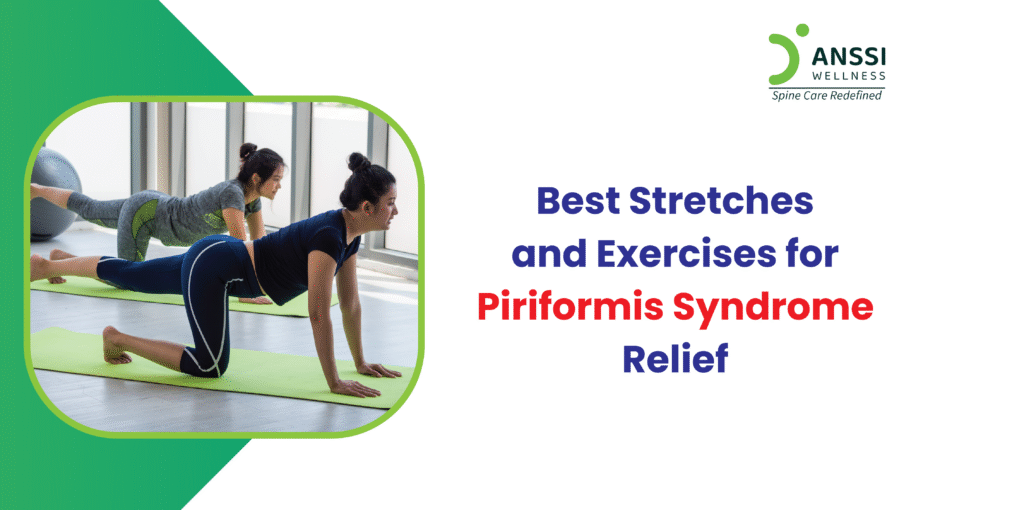Piriformis syndrome is a neuromuscular condition where the piriformis muscle, located deep in the buttocks, becomes tight or inflamed and compresses the sciatic nerve. Similar to sciatica, this often leads to a deep ache in the buttock and can cause radiating pain, tingling, or numbness down the back of the leg.
Fortunately, with the right stretches and exercises, you can find natural and lasting relief without medication or surgery.
Understanding Piriformis Syndrome
The piriformis muscle is crucial for hip rotation and stability. It connects the lower spine to the top of the femur and lies right above the sciatic nerve. When this muscle tightens or spasms, whether due to prolonged sitting, overuse, or muscle imbalances, it can compress the sciatic nerve, triggering discomfort or pain along the nerve’s path.
Common triggers of piriformis syndrome include:
- Long periods of sitting (especially with poor posture)
- Repetitive motions, like running or climbing stairs
- Weak gluteal muscles and core instability
- Previous hip or back injuries
Early recognition and treatment can prevent symptoms from worsening and reduce the need for invasive interventions.
Importance of Targeted Stretching and Exercise
Gentle, targeted movement is key to managing piriformis syndrome. Stretching the piriformis muscle can relieve pressure on the sciatic nerve while strengthening surrounding muscles helps correct imbalances that may be contributing to the issue.
The goal of these exercises is to:
- Loosen the piriformis and surrounding hip muscles
- Improve flexibility and blood circulation
- Support the pelvis and spine with better muscular control
- Reduce the risk of recurring symptoms
Make sure to perform all exercises slowly and mindfully, with a focus on proper form and breathing. Avoid any movements that increase sharp or radiating pain.
Recommended Stretches for Piriformis Syndrome
Here are some highly effective stretches to reduce piriformis tension and ease sciatic nerve compression:
1. Seated Piriformis Stretch
- Sit in a chair, ensuring your feet are flat on the ground.
- Place the affected leg over the knee of the other leg.
- Keeping your back straight, gently lean forward until you feel a stretch in the buttock.
- Hold for 20-30 seconds. Repeat 2-3 times on each side.
2. Figure-Four Stretch
- Lie on your back and keep both knees bent.
- Cross the affected ankle over the opposite thigh (making a figure 4).
- Hold the thigh of the lower leg and softly pull it toward your chest.
- Hold for 20-30 seconds. Repeat 2-3 times.
3. Knee-to-Opposite-Shoulder Stretch
- Lie flat on your back.
- Bend one knee and pull it across your body toward the opposite shoulder.
- Ensure that your back and hips are flat on the floor.
- Hold the stretch for 20-30 seconds. Repeat on both sides.
4. Supine Hip Stretch
- Lie on your back with your knees bent.
- Slowly pull one knee towards your chest while keeping your shoulders flat.
- You should feel a gentle stretch in the hip and lower back.
- Hold for 20 seconds and return back. Repeat on the other side.
These stretches are safe to do daily, especially if you experience tightness or stiffness after long periods of sitting or standing.
Strengthening Exercises for Long-Term Relief
Stretching helps relieve symptoms, but strengthening the glutes, core, and hips prevents them from returning by supporting spinal and pelvic alignment.
1. Bridges
- Lie on your back while keeping knees bent and feet flat.
- Lift your hips off the ground while tightening your core, so that your shoulders and knees are aligned in a straight line.
- Hold for 5 seconds, then lower.
- Repeat 10-15 times.
2. Clamshells
- Lie on your side while keeping the feet together and knees bent.
- Keeping your feet touching, lift up the top knee while keeping the hips stable.
- Lower slowly and repeat 10-15 times per side.
3. Side-Lying Leg Lifts
- Lie on your side with your legs straight.
- Raise the top leg slowly while keeping it straight, then lower it carefully.
- Perform 10-12 reps per side.
These exercises can be done 3-4 times per week to build pelvic and hip strength and prevent flare-ups.
Safety Tips and When to Seek Help
While these stretches and exercises are generally safe, keep these tips in mind:
- Always warm up with light walking or movement before stretching.
- Perform exercises on a flat, stable surface.
- If a stretch causes sharp pain or increased numbness, stop immediately.
- Avoid bouncing or jerking movements during stretches.
- Consult a physiotherapist or spine care specialist if symptoms persist or worsen despite regular stretching.
Piriformis syndrome can mimic other conditions like herniated discs, so it’s important to get a proper evaluation for an accurate diagnosis.
About ANSSI:
ANSSI Wellness focuses on improving the quality of life for patients suffering from spinal issues, aiming to provide relief where other conventional treatments have failed. Through advanced non-surgical spinal decompression treatment, ANSSI is committed to helping patients avoid surgery and recover in a safe, effective, and compassionate environment.
Connect with ANSSI Wellness on LinkedIn, Instagram, and Facebook for expert guidance.



